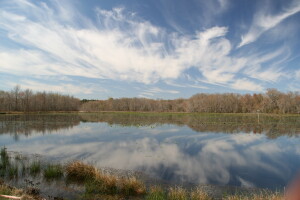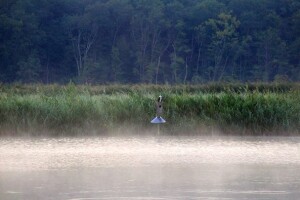EPA and Chesapeake Bay Foundation are failing to save the bay
The U.S. Environmental Protection Agency’s failure to sanction states for again failing to meet minimum Clean Water Act requirements for the Chesapeake Bay is an act of ethical cowardice. Since the signing of the first Bay Agreement in 1983, with pledges by the EPA and bay states to restore the bay, repeated agreements to reduce bay pollutants nitrogen, phosphorus and sediment were violated.
Then in 2010, a court settlement forced the EPA to impose a pollution diet with limits for each state for the three pollutants. The states were required to take actions to achieve the reductions, first for 60% of the reductions by 2017 and then 100% by 2025. Sanctions were threatened for failure to do so. Most states failed by 2017 with no sanctions imposed.
The EPA and most states realized, as 2025 grows closer, that once again the required reductions would not be met by wide margins unless they ramped up regulatory and funding measures. When they failed to do so, recalcitrant states called EPA’s bluff and on Oct. 11 at a self-congratulatory meeting, the EPA and the states jointly announced there would be no sanctions. Instead, the 2025 deadline was being recalibrated with a year-long reassessment to ascertain how to fix (read soften) clean-up requirements. The so-called Chesapeake Blueprint was collapsing and 39 years of formal clean-up plans and billions of dollars would not prevent poor water quality, dead zones, more harmful algal blooms, declining fisheries and flesh-eating human diseases.
Tragically, the self-anointed bay watchdog, the Chesapeake Bay Foundation, condoned this delay and failure to impose sanctions. In a Baltimore Sun article on Oct. 11, Hilary Falk, president of CBF, was quoted as praising the decision: “After decades of missed deadlines, the watershed and people who call it home deserve a new plan that addresses challenges like climate change and growth, builds on lessons learned, and accelerates progress.” Excuse me, but isn’t this exactly what the pollution diet and Bay Blueprint were supposed to do?
And how is a new plan going to be better than the last when public support has faded badly for the bay and our environment? A late October poll of voters asked: “Is there an issue that is especially motivating you as a voter?” At the bottom of the barrel was Bay/Environment/Climate with 1%. This is a sad commentary on the environmental community’s effectiveness in elevating these issues.
Other leaders in the environmental community vigorously attacked the retrenchment:
Patuxent Riverkeeper Fred Tutman: “The abandonment of the enforcement of the Chesapeake Bay cleanup plan is a betrayal of the aspirations of millions of residents and taxpayers … Oct. 11 is a date which will live in infamy. How could we be betrayed in our quest to simply have our government assure that it complies with Clean Water Act mandates?”
Tom Pelton, former Sun reporter and CBF staffer, now with the Environmental Integrity Project: “After two previous failed bay cleanup agreements, this time it was supposed to be different. Now the EPA and the bay states over the next year will likely go back and formulate even more modest cleanup targets and extended deadlines, allowing them to declare victory by moving the goalposts. Our lack of resolve reeks.”
Betsy Nicholas, executive director of Waterkeepers Chesapeake: “The bay cleanup agreement is missing its most important tools: enforcement and accountability … if we just throw more money at the problem, we’re never going to get there.”
Attorney General Brian Frosh bemoaned the overly congratulatory tone at the decisive meeting and stated: “Gov. Hogan and Virginia Gov. Youngkin congratulated themselves when EPA extended the deadline rather than imposing sanctions. This is not cause for celebration.”
A former EPA employee wrote me that: “I fully share your frustration with the complete lack of leadership within my former agency. Thanks for speaking up and speaking out! … I am truly embarrassed about my former employer.”
Why is it that the 500-pound gorilla of bay groups, the CBF, has acquiesced in this huge setback for bay restoration? In its 45 years of existence, CBF has grown to become a money vacuum cleaner raising $38 million in 2020. They hold $130 million in assets. Tom Pelton in his book, “The Chesapeake In Focus,” wrote of CBF’s spectacular success, not in saving the bay but with $57 million saved in stocks and investments. These investments generated $3.5 million last year. Much of this funding comes from corporate and governmental sources. This is why CBF’s advocacy is restrained to prevent antagonizing these grantors/donors especially since revenues shrank to $27 million last year.
I have worked with CBF for 50 years and was awarded its Lifetime Achievement Award, one of the first four to receive the honor. CBF has done much to educate school children and reach out to the public. But CBF is failing in saving the bay, rating bay health at D+ in its last State of the Bay Report Card in 2021. This was a 32, with 70 being an A for restored. Then-president Will Baker noted that “This is a sober reminder that the road ahead remains steep and the system still dangerously out of balance … we are witnessing apathy take hold and political will wane.” This year, CBF abandoned its graded report card.
Pelton wrote how CBF went from Save The Bay to Trade The Bay, receiving $21 million in agricultural grants, mostly from the U.S. Agriculture Department to work on voluntary farm practices. Agricultural pollution is the No. 1 source of bay pollutants and is the major reason bay states are not meeting pollution limits. CBF has refused to pursue legislation to better regulate agriculture, dooming bay restoration. Pelton goes so far in his book to note how CBF censored his writing about farm pollutants and the poultry industry before he quit CBF.
Steve Barry, a 40-year county school teacher and coordinator of Outdoor and Environmental Education, wrote of CBF’s failure to exert bold leadership especially on farm pollution tha t “Money helps but has not and will not gain the necessary pollution reductions. CBF is well-known by the Chesapeake Environmental community for failed leadership and insatiable appetite for money to support its huge budget.”
t “Money helps but has not and will not gain the necessary pollution reductions. CBF is well-known by the Chesapeake Environmental community for failed leadership and insatiable appetite for money to support its huge budget.”
CBF urged a moratorium on wild oyster harvest in 1991. As the population collapsed further, it then urged a transition from wild harvest to aquaculture in 2010. Recently, it switched positions despite further declines and refused to support such a sensible transition. Why? It received $3 million from NOAA for spat-on-shell plantings knowing that closing the wild harvest would boost wild population by 15-fold in two decades.
I agree with Riverkeeper Tutman: Oct. 11 is a date which will live in bay infamy. Sadly, EPA’s data showed that from 1985 to 2020, the improvement in actual water quality was so marginal that fully 71% of the bay’s waters do not now meet basic Clean Watter Act requirements — down just slightly from 74% in 1985. Unless CBF and others realize that money alone has not, and will not, solve the bay’s problems, the Chesapeake Bay will never be better than its current polluted condition.
Gerald Winegrad represented the greater Annapolis area in the General Assembly for 16 years. Contact him at gwwabc@comcast.net.